Assessment of Income Generating and Youths Empowerment Opportunities in Butchery Activities in the Abattoirs of Ogun State, Nigeria
Oyediran Wasiu Oyeleke1*, Omoare1 and Ayodeji Motunrayo2
1Department of Agricultural Extension and Rural Development, Federal University of Agriculture, Nigeria
2Department of Agricultural Education, Federal College of Education, Nigeria
Submission: March 24, 2018 ; Published: May 11, 2018
*Corresponding author: Oyediran Wasiu Oyeleke, Department of Agricultural Extension and Rural Development, Federal University of Agriculture, Abeokuta, Nigeria, Email: oyediran_wasiu@yahoo.com.
How to cite this article: Oyediran W O, Omoare, Ayodeji M. Assessment of Income Generating and Youths Empowerment Opportunities in Butchery Activities in the Abattoirs of Ogun State, Nigeria. Dairy and Vet Sci J. 2018; 6(1): 5556678.DOI:10.19080/JDVS.2018.06.555678
Abstract
The demand for paid-job to cater for basic needs such as food, shelter, clothing and health care is seriously on the increase among the youths. Meanwhile, the available white collar jobs are inadequate to accommodate majority of Nigerian youths after graduation from schools. This has made many youths to go into livestock production including butchery activities in the abattoirs for their livelihood sustainability. Butchery activities are capable of providing income and economic empowerment for the young people in Nigeria. Thus, this study assessed of Income Generating and Youths Empowerment Opportunities in Butchery Activities in the Abattoirs of Ogun State, Nigeria. Three hundred and forty young butchers were purposively selected from four abattoirs in Abeokuta, Ogun State. Data were collected with a well-structured interview guide and analyzed with inferential statistics. The results showed that the respondents were actively involved in skinning of the cow (92.90%), dressing the flesh and neating of intestine (83.50%) and cutting into pieces and separating the carcasses (74.10%). Results of chi-square analysis showed that challenges had a significant influence on the youths empowerment opportunities in butchery activities at p < 0.05 level of significance. The study therefore recommends that government at all level, and the private sector, should join hands and develop institutions that will expand cattle production and support youths empowerment through butchery in the study area.
Keywords: Potentials; Butchery; Youths; Cattle; Empowerment; Income; Opportunities; Unemployment; Robbery; Human trafficking; Kidnapping; Assassinations; Stunning; Exsanguinations; Skinning; Evisceration; Splitting.
Introduction
Unemployment is a global phenomenon whereby eligible workforce of a nation is denied employment or disengaged in the service of the nation 111. It is not only a serious economic issue but has social implications that affect almost all countries and all people either directly or indirectly. The question of unemployment becomes even more significant, considering that an unemployed and frustrated youth population is a reservoir for instability and spread of social vices. Alanana [2] observes that, it causes social disquiet and is the harbinger of the spate of crimes, perennial youth unrest and unstable socio-economic structure that has bedeviled several nations.Nigeria population is fast growing with the youth constituting the largest proportion about 40 - 50% of the population [3]. The National Bureau of Statistics [4] and Central Bank of Nigeria Survey [5] indicates that the unemployment trends in Nigeria, from 2010 - 2014 are as follows: in 2010; 21.1 percent, 2011; 23.9 percent, 2012; 24.3 percent, 2013; 28.5 percent and 2014; 30 percent. In Nigeria, there is high incidence and the alarming rate of unemployment. Several scholars and commentators on social and economic issues have canvassed on a host of factors responsible for the high and ever-rising levels of unemployment World Bank [6-8].
The contributing factors to this dilemma is the inability of government and private organizations to provide sufficient job opportunities to absorb the large number of graduates turn out annually from Nigeria tertiary institutions. To worsen the situation, the large proportion of the graduates lack entrepreneurship skills that can be utilized for self-employment. By implication, unemployment rate has been on the increase. The graduates in different field are roaming the streets of Nigeria as a result of lack of entrepreneur, technical and vocational skills necessary for employment as skilled personnel. The mass unemployment situation has led to series of odd vices like armed robbery, human trafficking, kidnapping and assassinations all over in Nigeria. This state of affairs has resulted in instability and insecurity in this country [9]. Efforts to get a means of leaving have led youth's particularly secondary school leavers to take up butchery activities as youth empowerment channel in Nigeria. Youth empowerment is a process where children and young people are encouraged to take charge of their lives by addressing their situation and then take action in order to improve their access to resources and transform their consciousness through their beliefs, values, and attitudes. In the drive towards achieving poverty alleviation and youth empowerment, a major agenda of the agricultural transformation, is the development of the Nigerian youth through remodeling the nation's agricultural sector [10]. Youth are the major group much needed for agricultural transformation.
In Nigeria, as in many countries of the world, it has been realized that government alone cannot provide for the needs of all the youth in the nation. Agricultural businesses in developing countries (including Nigeria) offer an opportunity for market based economic development that creates benefits throughout global value chains. Agriculture accounts for about 30 percent of Africa's Gross Domestic Product (GDP) and 75 percent of total employment. Given the World Bank's estimate that economic growth in the agricultural sector is twice as effective in reducing poverty as growth in other sectors of the economy, strengthening agricultural value chains may be among the most effective ways to address global poverty (World Bank, 2008). Production of beef from cattle provides very nutritious protein consumption in the human diet and good earnings for both the pastoralists and butchers [11]. It goes beyond direct food production to include multi-purpose uses, such as skins, fiber, fertilizer and fuel, as well as capital accumulation. Cattle are closely associated to the social and cultural lives of several million of resource-poor people for whom animal ownership ensures varying degrees of sustainable farming and economic stability. Adesipe [12] stated that it provides an important role in the Nigerian economy not only in terms of its contribution to Gross Domestic Product (GDP).
Butchery in the beef production includes stunning, exsanguinations, skinning, and evisceration, splitting and selling of the beef and its products to the consumers. Economically butchery activities provide an important source of empowerment and income generation for the youths in the developing world and it has an important socio-cultural position in the rural areas. Youth empowerment is essential both to realize youth's rights and to achieve broader development goals such as economic growth, poverty reduction, health, education and welfare. However, despite the empowerment opportunities found in beef production, attention of government and agricultural experts has not been geared towards this sector in terms of training, infrastructural facilities, hygiene, finance and standardization. In addition, little or no study has assessed the economic potentials of butchery to the youth empowerment despite the fact that there exist some groups of youth that are involved in butchery activities as a means of generating income and livelihood sustainability. Looking at the importance of butchery activities as a means of economic empowerment for the youths, an in-depth study of the butchery activities in the abattoirs is therefore necessary in order to gain an insight into the potentials of butchery activities as means of fighting twinning problems of youth unemployment and poverty in Ogun State, Nigeria.
Specific objectives
a) Describe the personal characteristics of the youths involved in cattle butchery activities in the study area;
b) Identify the various butchery activities undertaken by the respondents in the study area;
c) Identify predominant processing methods used by the youth in cattle butchery in the study area;
d) assess the extent of income generation and youths empowerment through the butchery activities in the abattoirs in the study area;
e) Identify challenges faced by the youths in butchery activities in the abattoirs in the study area.
Hypotheses
H01: There is no significant relationship between the personal characteristics of the respondents and youths empowerment opportunities in butchery activities in the abattoirs.
H02: There is no significant relationship between challenges faced by the youth in butchery activities and youth's empowerment opportunities in butchery activities in the abattoirs.
Review of Literature
Implications of youth unemployment and poverty in Nigeria
Nigeria's population was about 167 million people in 2012 [4]. The National Population Commission (NPC) [13] states that about half of the population is made of youth, that is, individuals between 18 and 35 years of age. Akande [14] stressed that, unfortunately, as the youth population grows so does the unemployment rise. In fact, unemployed youth numbered about 11.1 million in 2012 [14]. Youth are very important resources for every nation especially for sustaining agricultural productivity, an important sector for the development. The youth is a stakeholder in the development process especially in view of the great assets of youth, resilience, resourcefulness and perseverance. Unfortunately, this category of people is virtually left out in policies and programmers considerations even though this is a critical stage for this group of people since this is a period of transition into adulthood. Furthermore, the National Youth Development Policy (2001) asserts that the youth are the foundation of a society; their energies, inventiveness, character and orientation define the pattern of development and security of a nation.
The youth are a particular segment of the national population that is sensitive, energetic and the most productive phase of life as citizens. The youth are also most volatile and yet the most vulnerable segment of the population in terms of socio-economic, emotion and other aspects [15]. These entities called youth has gained a wide currency and has been variously classified into such age brackets as 15-24 years (World Bank and United Nations); 15-29 years (Commonwealth Youth Programmes); while for many countries, the figure varies from 13-18 years, 20-25 years, and 12-20 years [16]. Youth is a state of transition between childhood and adulthood characterized by the possession of attributes such as energy, intelligence and hopes which enable the youth to improve their knowledge and capabilities [17]. Youth can provide opportunities for the acquisition and development of valuable knowledge and skills, which have direct impact on them in terms of employment opportunities and economic viability.
Nigeria as a nation has no doubt seriously underdeveloped the youth population, the consequence of this abject neglect of the Nigerian youth on national security and economic development are best imagined. In all the crannies and corners of the Nigerian cities the pathetic condition of the youth as a result of systemic disempowerment is enormous. To eke out a leaving therefore, the devil finds useful tools in their hands to unleash their frustration on the general society via hawking adulterated petroleum products (South-South), Urchins (area boys) syndrome in Lagos, (South-West), while rabbles of militants in the Niger Delta, Boko- Haram North-East on the part of the male youth, women and teenagers, while the female youth result to prostitution (call- girl) activities and other menial duties, a real life statistics which could serve better than official statistics in unraveling the extent to which Nigeria has underdeveloped and or disempowered her youthful population arising from pervasive unemployment and poverty in Nigeria [18].
Theoretical Framework
Sociological model shed more light on the nexus of unemployment, poverty and development in Nigeria. One of such sociological model that carefully explains the context of unemployment in Nigeria is the theory of surplus value by Marx and Engels cited in [19]. Marx believed that capitalist societies like Nigeria always had and would continue to have high level of unemployment. He believed such economies went through cycles-periods of expansion in which there was full employment which were followed by periods of crises during which unemployment rose. Recoveries from crises were only temporary. Marx asserted that capitalist economies worked in a way of favoring the few bourgeoisies, capitalist's property class at the expense of the large proletariat, working nonproperty class. According to Marx, unemployment is inherent within the unstable capitalist system and periodic crises of mass unemployment are to be expected. The function of the proletariat within the capitalist system is to provide a "reserve army of labour” that creates downward pressure on wages. This is accomplished by dividing the proletariat into surplus labour (employees) and under-employment and unemployed as well [20]. These reserve army of labour fight among themselves for scarce jobs. At first glance, unemployment seems inefficient since unemployed workers do not increase profits. However, unemployment is profitable within the global capitalist system because unemployment lowers wages which are costs from the perspective of the owners [19].
In Nigeria context, the Nigerian super-rich politicians together with super-rich capitalists formed a cabal and logically established economic imperialism. According to Oduwole [19], economic and social policies formulated by the government are not in any way of benefit to the Nigerian youth. The policies that fail to emphasize technical and entrepreneurship development but recognize cheap labour in the name of white collar jobs. From this perspective, the system discriminates the riches (capitalists) against the poor (voiceless youth) and creates wider gap between the rich and the poor with attendant high impoverishment among the unemployed youth. Unfortunately, agriculture sector (crop, aquaculture, extension, livestock etc.) that provides employment opportunities for the timid rural population is put in bad shape due to poor funding and corruption. Consequently, resulting into long years of unemployment, deprivation and frustration which are major causes of crime amongst Nigerian youth because there is nothing else to occupy their time or provide a means of income.
Materials and Method
Description of the Study Area
Ogun State is one of the six States in the southwest, Nigeria. The state was created in February 3rcl 1976. It is bounded in the west by Republic of Benin, bounded in the south by Lagos State and Atlantic Ocean, in the North by both Oyo and Osun States and in the East by Ondo State. The State lies between the latitudes 7°18'N and longitude 5°55'E. It is situated within the tropics covering 16,409.29km2 with a population of about 4,054,272 [3]. Ogun State is heterogeneous state, inhabited predominantly by the Egba, Yewa, Ijebu, Remo, Awori and Egun who belong to the Yoruba ethnic group on the Africa Continents. The population of males in Ogun State is 1,847,243 while the population of female is 1,880,855 according to Nigeria Population Census final population release. The state is approximately covering 1.9 percent (i.e. 16,762km2) of Nigeria 923,219km2 land areas. The State has bimodal rainfall pattern which reaches its peak in July and September and it comprises of mostly agrarian communities which engages the farming activities of both males and females, in cash crops and food crops in order to meet the livelihood needs of the farmer, in addition to their foreign exchange. Most of the crops grown in Ogun State include cassava, rice, maize, melon, cotton, cocoyam, cocoa, yam, cowpea etc.
The emphasis of traditional Agriculture in Ogun State is more on crops, while the livestock raised is supplementary. This study was carried out in Abeokuta metropolis of Ogun State, Nigeria. Abeokuta is the largest city and state capital of Ogun State in Southwest, Nigeria. It is situated on the East bank of the Ogun River, near a group of rocky outcrops in a wooded savanna 77 Kilometres north of Lagos by railway and 130 Kilometres by water [21]. Abeokuta metropolis has a total population of 593.143 people as at 2006 [3]. Abeokuta metropolis has only two Local Government Areas namely Abeokuta South Local Government Area having its headquarters at Ake with 15 wards and Abeokuta North Local Government Area having its own headquarters at Akomoje with 17 wards. Cottage industries in Abeokuta include pottery at Ijaiye, tye and dye with locally grown indigo at Itoku, wood carving, blacksmiths, etc. Modern industrial produce in Ogun State include high quality beer and clay bricks, bicycle tires, ceramic goods, carpets and clothing materials. Butchery activities are very common among the residents of Abeokuta metropolis while there are many abattoirs in every part of the city (Figure 1).
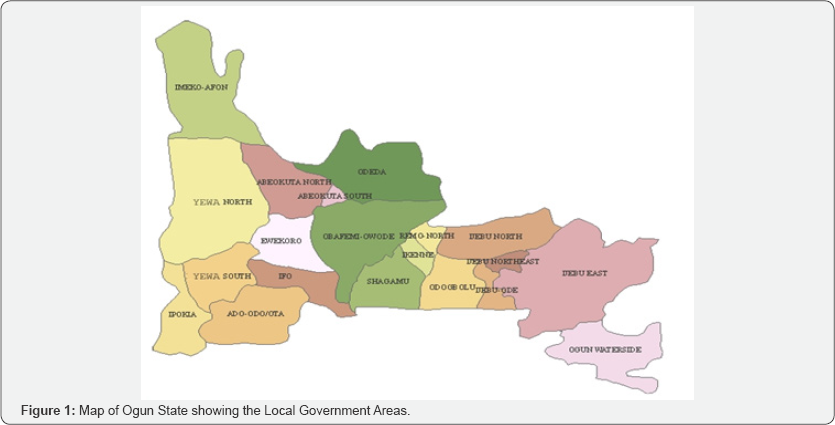
Sampling Technique and Sample Size
Multi-stage sampling technique was used in the selection of respondents for this study. First stage, four abattoirs were purposively selected from Abeokuta metropolis (i.e. Lanfewa, Asejere, Odo-Eran and rounder-mile 12 abattoirs). Finally, 85 young butchers were randomly selected from the list of butchers association in the selected four abattoirs to make 340 respondents as sample size for this study.
Data Collection Method
Data were collected with the aid of well-structured interview guide and field observations. The interview guide was subjected to face and content validity through experts in the field of Agricultural Extension and Rural Development. Ambiguous items were immediately removed. Test re-test was conducted at two weeks interval with twenty young butchers who were not part of the study in Ifo abattoir, Ogun State to ascertain the reliability of the instrument. Pearson Product Moment Correlation (PPMC) was used to establish a reliability coefficient of 0.93 is reliable since the reliability coefficient of 0.75 and above is adduced to be reliable for instrument for this study was reliable.
Measurement of variables and Data analysis
Gender, educational and marital status, and membership of butcher association were nominally measured while age, household size and years of experience were measured at ratio level. Beef processing methods were conceptualized as Mechanical and Manual. Youth involvement was measured with a 3-point rating scale of AI - Actively Involved, LI - Less Involved, and NI - Not Involved. Responses on the extent of youth empowerment and poverty alleviation were obtained with a self-constructed statements using Yes and No. Challenges faced by the youth in butchery activities were ranked based on the degree of severity. Chi-square and linear regression were used to analyze the hypotheses of the study. The primary objective of regression analysis is to determine the various factors which cause variations of the dependent variable (Koutsoyiannis, 2001). It was assumed that youths empowerment opportunities (E), is a function of age, gender, education, household size, years of experience and skill acquisition. Thus the explicit model is:
Linear: E = α + b1X1 + b2X2 + b3X3 + b4X4 +b5X5 +bnXn + ei
Where:
E = youth involvement (scores)
X1 = Age (years);
X2 = Gender (male = 1, female = 0)
X3 = Household size (number of people);
X4 = Experience (years);
X5 = Skill acquisition (apprenticeship =1, Otherwise = 0)
α = Constant; and
ei = error term
Personal Characteristics of Respondents
The result in ( Table 1) revealed that about 54.1% of the respondents were between 25 - 30 years of age, 23.5% were less than 25 years with the mean age of 28.5 years. This shows that most of the butchers are economically active and they have strength to cope with rigors associated with butchery activities. This result agrees with findings of Salifu and Teye that butchering profession is quite energy demanding. In the most adverse and risky situations, young people have an extraordinary resilience and ability to cope. In Africa, 20% of the population aged between 15 and 24 years, comprising more than 20% of the population and a large majority lives in rural areas (United Nations Population Fund, 2006). Most (90.6%) of the respondents were male while 9.6% were female. This indicates that men are predominant in butchery activities and it could be attributed to tedious nature of the butchery operations. Majority (68.2%) of the respondents were married while 20.0% were single and 11.8% had a separated home. Youths are actively engaged in family livelihood activities and play key support roles within their families and usually desire to be acknowledged, emotionally and financially, for such contributions and for the supporting role they played within their families, in addition to controlling the financial returns from their activities (Pacific Agricultural and Forestry Network (PAFNET), 2010). All (100%) the respondents had acceptable levels of formal education, 70.0% out of this figure attended secondary school, 16.5% had tertiary education while 12.9% went to primary school.
The results disagrees with the findings of Salifu and Teye, (2006) in Ghana that, the butchers have no formal education and that it could hamper the acceptability of modern slaughtering practices as well as adherence to strict hygienic and standard slaughtering practices. Moreover, about 67.1 of the respondents inherited butchery skills from their parents, while 32.9% got the butchery skills through apprenticeship. However, none (0.0%) of the respondents passed through vocational institution to acquire the butchery skills. The reason for this is not far fetch because butchery is not imbedded in most academic curricular in Nigeria. Furthermore, the results revealed that 55.3% of the respondents had 3 - 8 people in their households while 38.8% had less than 3 people in their households and 5.9% had more than 8 people in their households.
The mean household size was 4 people. This is an indication that the household size was relatively small which implies that the respondents are still much younger to have a large family size. The result also showed that the mean year of butchery activities was 6.8 years. Majority (73.0%) of the respondents had spent 5 - 10 years in butchery activities while 18.8% had spent less than 5 years in butchery activities and 8.2% had spent more than 10 years in butchery activities in the study area. This result indicated that the butchers got involved at their early age. Also, all (100%) the respondents were members of Butcher Association. This shows that the joining of association is mandatory and it is considered to be very important to every butcher in the study area (Table 1).

Source: Field Survey, 2017
Butchery Activities of The Youths in the Abattoirs in Ogun State
Butchery is a traditional line of work [22]. In the industrialized world, slaughterhouses use butchers to slaughter the animals, performing one or a few of the steps repeatedly as specialists on a semi-automated disassembly line. The steps include stunning (rendering the animal incapacitated), exsanguinations (severing the carotid or brachial arteries to facilitate blood removal), skinning (removing the hide or pelt), evisceration (removing the viscera) and splitting (dividing the carcass in half longitudinally). The results showed that only very few (7.0%) of the respondents were actively involved in slaughtering of the cow and 17.6% fetched water for cleaning the slaughtered cow while about 92.9% did skinning of the cow. About 74.1% of the respondents were involved in cutting and separating the carcasses into pieces and 83.5% carried out dressing of the flesh and beating of the intestine. Also, the results revealed that 61.2% of the respondents were actively involved in selling of the beef and other products while 21.2% engaged in hawking the beef along major streets in the study area. It was only few (14.1%) of the respondents that were doing cleaning and tidying up of the abattoirs. Primarily, butchery consists of selecting carcasses, sides, or quarters from which primal cuts can be produced with the minimum of wastage; separating the primal cuts from the carcass; trimming primal cuts and preparing them for secondary butchery or sale; and storing cut meats [23] (Table 2).
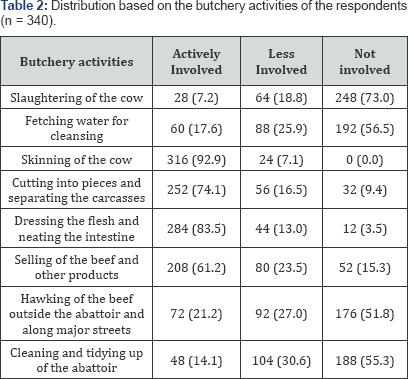
Source: Field Survey, 2017. Values in parenthesis are in percentages
Predominant Processing Methods of Carcasses in the Abattoirs
In parts of the world, it is common for butchers to perform many or all of the butcher's duties. Where modern facilities are less common, butchery skills are required to sell the meat of slaughtered cattle (sokanu.com, 2015). The results showed that carcasses were processed manually in the study area. Slaughtering, skinning, washing, and trimming/splitting were carried out manually (100%). Meanwhile, pumping of the cow was done with compressor machine in the abattoirs (100%) (Table 3).
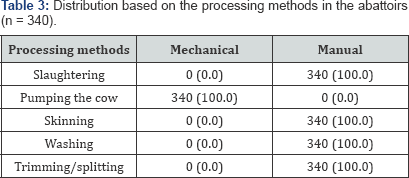
Source: Field Survey, 2017. Values in parenthesis are in percentages.
Extent ofIncome Generation And Youths' Empowerment Opportunities in the Abattoirs
Agriculture remains fundamental to poverty reduction and economic growth in the 21st century (World Bank, 2008). The report further posits that 75% of the world's poor are from rural areas and most are involved in agriculture, an activity which requires sustenance especially by the youths who are the leaders of tomorrow. The results of this study revealed that about 74.1% of the respondents were occupied by the butchery activities and 87.1% spent appreciable of their time in abattoirs instead of roaming about the street while 69.4% stated that butchery activities are very interesting. All (100%) the respondents affirmed that butchery is profitable and capable of reducing poverty and that they were economically empowered through butchery activities. The findings support Oyenuga [24] assertion that over 50% of the population in the rural areas engage in agriculture and contributes to production of cattle in Nigeria. Therefore, to be involved in butchery activities is a decision brought about by the felt needs for food, healthy living and other social needs of the youths (Table 4).
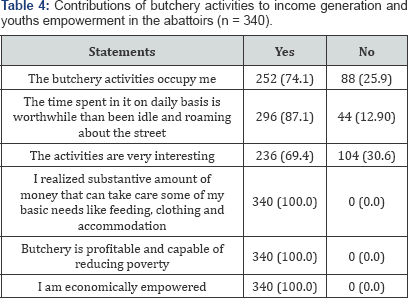
Source: Field Survey, 2017. Values in parenthesis are in percentages.
Challenges Faced by the Youths in Butchery Activities in the Abattoirs
Being 40% of the working-age population rural youths who are attached to agriculture are disadvantaged and this is because consideration of the youth as future leaders in Africa has not received adequate attention [3]. This category of people is the driving force behind economic prosperity in future decades, only if policies and programmers are in place to enhance their opportunities. The respondents indicated that limited access to credit and poor financial support from formal financial institutions (95.3%), non-availability of storage facilities for the processed beef and other products (91.8%) and high cost of cattle and difficulty in sourcing healthy cattle (88.2%) were the major challenges confronting their involvement in the butchery activities. Codex Alimentarius Commission (2005) recommended that persons engaged in meat production and hygiene activities should be trained, and/or instructed to a required level of training, knowledge, skills, and ability. These results corroborate the findings of Thakur cited in Oyediran, 2015 that poor infrastructure of butcheries is the major challenge confronting butchery business in developing countries particularly sub- Saharan African. Other serious challenges include poor extension support and training on management and hygiene (85.9%), poor infrastructure in the abattoir (84.7%), exorbitant tax payment to the government (75.3%) and lack of standard measuring units for beef (70.6%). Exposure of youths to modern technologies that give them access to information from around the world and changing needs of young people must be recognized especially by leaders, thus harnessing the opportunities and challenges thereof [25-28] (Table 5).
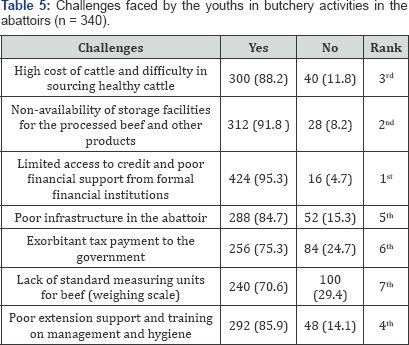
Source: Field Survey, 2017. Values in parenthesis are in percentages.
Hypotheses Testing
Relationship between the personal characteristics of the respondents and youth empowerment opportunities in butchery activities in the abattoirs
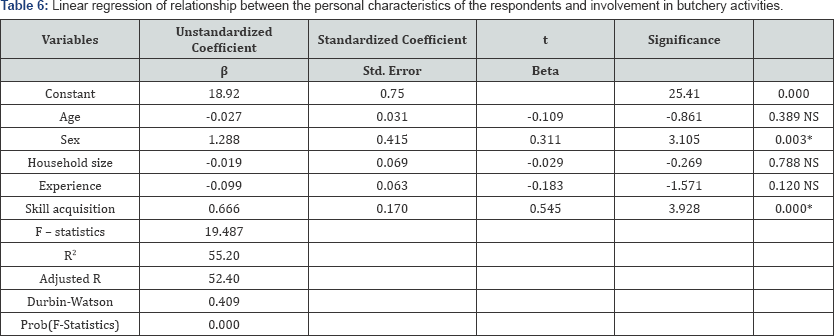
Source: Field Survey, 2017. S*: Significant at 0.01 level; NS: Not-significant at 0.05 level.
The coefficient of sex was significant at 1% level of significance and positively signed (t = 3.105, p =0.003). The positive relationship implies that sex has influence on the youth engagement in butchery activities and this may be accounted for the dominance of male in butchery in the study area. Also, skill acquisition was significant at 1% level of significance (t = 3.928, p = 0.000). This means that the more the skills acquired by the youths the more their activeness would be. Age (t = -0.861, p = 0.389), household size (t = -0.269, p = 0.788) and butchery experience (t = -1.571, p = 0.120) were not significant at 5% level of significance. It can therefore be said that age, household size and butchery experience have no influence on the youth participation in butchery. The negative signs of age, household size and butchery do not translate to higher level of youth participation. The co-efficient of R2 indicated that 55.2% of the variation in youth empowerment opportunities in the sample was brought about by the explanatory variables used in the model. The significant F-statistic affirmed that the null hypothesis (H01) in the sample remained rejected at 1% level of significance [29-33]. That is, alternate hypothesis (Ha1): There is significant relationship between the personal characteristics of the respondents and involvement in butchery activities is accepted (Table 6).
Relationship between challenges faced by the youth in butchery activities and youth empowerment opportunities in butchery activities in the abattoirs
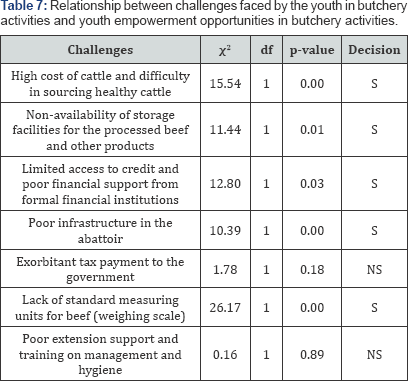
Source: Field Survey, 2017. S: Significant at 0.05 level; NS: Not- significant at 0.05 level.
Chi-square results showed that significant relationship existed between high cost of cattle and difficulty in sourcing healthy cattle (χ2 = 15.54, df = 1, p = 0.00), non-availability of storage facilities for the processed beef and other products (χ2 = 11.44, df = 1, p = 0.01), limited access to credit and poor financial support from formal financial institutions (χ2 = 12.80, df = 1, p = 0.03), poor infrastructure in the abattoir (χ2 = 10.39, df = 1, p =0. 00), lack of standard measuring units for beef (χ2 = 26.17, df = 1, p = 0.00) and youth empowerment opportunities in butchery activities at p < 0.05 level of significance. It implies that the challenges have influence on the youth involvement in butchery activities. However, exorbitant tax payment to the government (χ2 = 1.78, df = 1, p = 0.18) and poor extension support and training on management and hygiene (χ2 = 0.16, df = 1, p = 0.89) were not significant with youth involvement in butchery activities at p < 0.05 level of significance. Therefore, the null hypothesis that "there is significant relationship between challenges faced by the youth in butchery activities and youth empowerment opportunities in butchery activities in the abattoirs.” is rejected. Agriculture being one of the foundation pillars of any society can only function as such if these challenges are reversed. For instance improving youth productivity in the agricultural sector and exploring effective livelihood diversification is imperative. The youth with the dynamism and flexibility has the potential as an agent of positive change and this should be ensured by development programmes. Therefore, the involvement of youth in agriculture through which the spirit of self-help is promoted is of paramount importance (Table 7).
Conclusion and Recommendations
The study concludes that the butchers were young, economically active, and more experienced. Butchery activities in the abattoirs were carried out manually. The respondents affirmed that butchery is profitable and capable of reducing poverty and that they were economically empowered through butchery activities in the abattoirs. However, the youths were confronted by limited access to credit and poor financial support from formal financial institutions, non-availability of storage facilities for the processed beef and other products and high cost of cattle and difficulty in sourcing healthy cattle. In the same vein, significant relationship existed between the personal characteristics of the respondents, challenges facing the youth and empowerment opportunities in butchery activities in the abattoirs. It is hereby suggested that government at all level, and the private sector, should join hands and develop institutions that will support youth empowerment through butchery in the study area. Credit facilities should as well be provided to the youths at affordable interest rate while extension agents should be motivated to provide the required extension services to the youth involved in butchery activities in the abattoirs [34-37]
References
- Abiodun SO (2010) Analysis of Mismatch between supply of skills and University graduate unemployment in Nigeria. Dissertation, Lagos State University, Nigeria.
- Alanana OO (2003) Youth Unemployment in Nigeria: Some Implications for the Third Millennium. Global, Journal of Social Science 2(1): 21-26
- National Population Commission NPC (2006) Federal Republic of Nigeria, Nigeria Head Count, Nigeria.
- National Bureau of Statistics (2012) Labour Force Statistics No. 476. The NBS Publication, Abuja, Nigeria.
- Central Bank of Nigeria (CBN) (2007) Statistical Bulletin, Abuja, Nigeria.
- Acs ZJ, Armington C (2006) Entrepreneurship, Geography, and American Economic Growth. Cambridge University Press, New York, USA.
- Fritsch M (2004) Entrepreneurship, Entry and Performance of New Business Compared in Two Growth Regimes: East and West Germany. Journal of Evolutionary Economics 14(5): 525-42.
- vanPraag M, Versloot PH (2007) What Is the Value of Entrepreneurship? A Review of Recent Research. Small Business Economics 29 (4): 35182.
- Ebenehi AS, Oguche IO (2012) Vocational and technical education and the survival of the youths. A paper presented at a conference held by the School of Vocational and Technical Education between 14th - 16 th July, 2012, Kogi State College of Education, Ankpa, Nigeria.
- Akinwumi A (2012) Press briefing on Agricultural reform. In: Owuje Harry, Tackling food insecurity. The Tide Newspaper. Nigeria.
- Oyediran WO (2015) Assessment of Veterinary Inspection Practices on quality of beef produced in Ibarapa Central Local Government Area of Oyo State, Nigeria. International Journal of Veterinary Sciences Research 1(2): 36-45.
- Adesipe IU (2005) Certificate for Agricultural Science. Pearson Education Company Limited, Calabar, Cross-Rivers State, Nigeria, p. 26.
- National Population Commission NPC (2013) Nigeria's Unemployment rate rises to 23.9% - NPC, Punch Newspaper, Nigeria.
- Akande T (2014) Youth Unemployment in Nigeria: A situation Analysis, Africa in Focus, the Brookings Institute, Washington DC, USA.
- Anasi SN (2010) Curbing Youth Restiveness in Nigeria: the role of information and libraries. Library Philosophy of practice.
- Bello-Kano I (2008) Differences without Positive Terms: Intentionality, Subjectivity and Agency in the Discourse of Youth. Aminu Kano Centre for Democratic Research and Training (CDRAT) Mambayya House, Bayero University, Kano, Nigeria.
- Erenie S (2002) Youth, a Stronghold for Sustainable Agricultural Extension Delivery and Development. Proceeding of the 8th Annual Conference of agricultural Extension Society of Nigeria, p. 15-20.
- Onuoha CF (2008) Gender and National Development. A Paper delivered at a Seminar on the Theme: Conflict and Development: The Gender Question, organized by the African Centre for Strategic Research and Studies (ACSRS), National Defence College,New Delhi, India.
- Oduwole TA (2015) Youth unemployment and poverty in Nigeria. International Journal of Sociology and Anthropology Research 1(2): 23-39.
- McClellan D (2009) The Condition of the Working Class in England, Oxford University Press, UK.
- Hoiberg DH (2010) Abeokuta. Encyclopedia Britannica. In: A-ak Bayes (15th edn), Chicago, IL: Encyclopedia Britannica Inc. p. 27.
- Merriam-Webster's Dictionary and Thesaurus (2013) Definition of Butcher. Butcher, Massachusetts, USA.
- Sokanu (2015) What does a butcher do? Sokanu.
- Oyenuga VA (2002) Intensive Animal Production on Subsistence Scale. Proceeding of Third World Conference on Animal Production, Melbourne, Australia, pp. 393.
- Mangal H (2009) Best Practices for Youth in Agriculture: The Barbados, Grenada and Saint Lucia Experience. Final report.
- Codex Alimentarius Commission (FAO & WHO) (2005) The tenth session of the codex committee on meat hygiene. Auckland University Press, New Zealand.
- Kanti NN (2015) The challenge of unemployment among youth. Daily Trust Newspaper, Nigeria.
- Koutsoyiannis A (2001) Theory of Econometrics - An Introductory Exposition of Econometric Methods. Macmillan Press Ltd, London, UK.
- Mbam BN, Nwibo SU, Odom CO (2010) Rural Poverty and Reduction Strategies: A Case Study of Arochukwu Local Government Area of Abia State, Nigeria. African Journal of Professional Research in Human Development. De-Caritas Publishers Port Harcourt 6(1): 45-52.
- Roberts B (2007) Youth and Poverty Reduction Strategy Processes in Sub-Saharan Africa. In: African Insight, 37 (3): p. 432-453.
- Salifu S, Teye GA (2006) The Contribution of the various Ruminant species to Meat Production in the Tamale Metropolis. The Savanna Farmer Promoting local innovation in Northern Ghana 7(2): 35-37.
- Vanguard newspaper online (2013) 54% of Nigerian youth were unemployed in 2012. 2012 National Baseline Youth Survey Report in collaboration with the Federal Ministry of Youth Development, Vanguard, Apapa Lagos.
- World Development Report (2007) Young people today, and in 2015. United Nations Publication, New York, USA.
- National Bureau of Statistics (NBS) (2012) Labour force survey. Abuja, Nigeria.
- Federal Republic of Nigeria (FRN) (2004) National Policy on Education. Revised (edn), Lagos: NERDC Press, Nigeria.
- Oyediran WO, Omoare AM (2016) Potentials and Challenges of Agricultural Education in reducing Postharvest losses and Food Insecurity in Ogun State, Nigeria. American Research Journal of Agriculture pp. 2378-9018.
- Oyediran WO, Omoare AM, Ajagbe BO, Sofowora OO (2014) Attitude of Cocoa Farmers to Growth Enhancement Support Scheme (GES) in Ogun State, Nigeria. World Journal of Biology and Medical Sciences 1(3): 108 - 117.






























